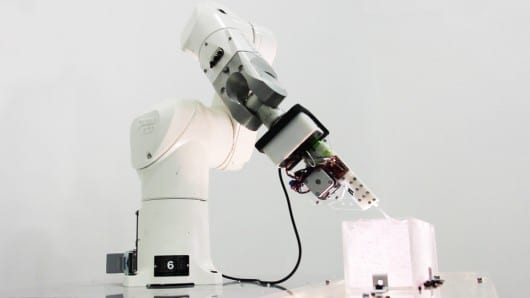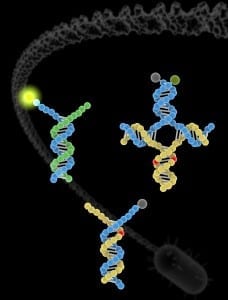
Not only does this allow freeform additive fabrication on six axes, it also enables an “undo” function
The additive layer process of conventional 3D printers means they are usually limited to bottom up fabrication on three axes. The Mataerial printer managed to defy gravity by using a quick-solidifying print material, but now the LA-based NSTRMNT team led by Brian Harms, a Masters student at the Southern California Institute of Architecture, has created a 3D printing process called suspended disposition that gets around gravity by printing objects within a gel. Not only does this allow freeform additive fabrication on six axes, it also enables an “undo” function.
The NSTRMNT 3D printer utilizes a six-axes robotic arm from Stäubli Robotics with a peristaltic pump mounted on it. This injects a light-cured liquid resin into a gel that acts as a support structure for the printed object. The pump’s flow rate is controlled by an Arduino, which is coordinated with the motion of the robot to create the prints. The Arduino also controls the pump’s flow direction, giving it the ability to delete parts of the printed object by sucking instead of extruding.
After a print is completed, the liquid resin is exposed to ultraviolet light for one to two minutes, which hardens the structure. “We also have UV LEDs mounted on the pump, but in our experience they take far too long to cure the resin,” explains Harms. Like printed support structures on traditional 3D printed objects, the gel holds the resin in place until it is cured and ready for removal.
“The gel can be reused many times, as long as it does not dry out,” Harms tells Gizmag. “We got in the habit of covering the gel container when not in use, and we could reuse the gel for several weeks. We haven’t fully tested the maximum duration for reuse, but I imagine it could be a few months.”
To calculate the movements of the robot’s joints, the NSTRMNT printer uses an inverse kinematics solver that Harms developed for Grasshopper (the 3D modeling plugin for Rhino, a 3D CAD program).
“We design our geometry, it is converted to toolpaths, and we run the robot along those paths. But, the robot can be controlled manually using the controller pendant that comes with each robot,” Harms tells Gizmag. This allows a user to pause an operating print and move the robot as the pump extrudes resin. “In this way it is a sort of live drawing tool – kind of like an etch-a-sketch in 3D.”
The Latest Bing News on:
Printing in gel
- MIT spin-off Rapid Liquid Print raises $7M for 3D printingon May 7, 2024 at 1:30 pm
MIT spin-off Rapid Liquid Print has raised $7 million in funding for its novel liquid-based 3D printing technology.
- Programmable Living Materials Created Using Synthetic Biology and 3D Printingon May 2, 2024 at 2:07 am
Scientists are harnessing cells to make new materials that can grow, repair themselves and even respond to their environment.
- Best Gel Mattress for 2024on May 1, 2024 at 3:31 pm
If you’re a hot sleeper and you’re looking for a new mattress with pressure relief and motion isolation, consider switching to a gel memory foam mattress. This is a popular choice in ...
- Marriage of synthetic biology and 3D printing produces programmable living materialson May 1, 2024 at 6:42 am
Scientists are harnessing cells to make new types of materials that can grow, repair themselves and even respond to their environment. These solid "engineered living materials" are made by embedding ...
- Crafting Programmable Living Materials With Synthetic Biology & 3D Printingon May 1, 2024 at 4:59 am
New study uses 3D printing and genetically modified plant cells to create complex, self-repairing materials that could revolutionize biomanufacturing and construction. Scientists are harnessing cells ...
- Kulfi’s Conditioning Brow Gel Gave Me Perfectly Sculpted and Fluffy Browson April 30, 2024 at 4:44 am
Kulfi Beauty's Free the Brow brow gel ($26) truly changed the brow game for me. The brow gel is clear, and formulated with conditioning ingredients like safflower oil, sunflower oil, and Roselle ...
- Pioneer boys volleyball team concludes season with sweep at Woodland High School in final GEL matchon April 26, 2024 at 1:53 am
Click to share on Facebook (Opens in new window) Click to share on Twitter (Opens in new window) Click to print (Opens in new window ... the Patriots (8-9, 5-9 GEL) swept the Wolves (0-14) in the last ...
- 5 in a row: Pioneer softball team prevails at Woodland High School to earn fourth shutout during win streakon April 25, 2024 at 11:09 pm
For the final time, at least for a while, the Patriots and Wolves softball teams faced off in a Golden Empire League matchup on Wednesday.
- This 'Gel Printing' technique will leave you stupefied and mesmerizedon April 25, 2024 at 5:00 pm
This uber-captivating footage features her demonstrating the surreal 'Gel Printing' image transfer technique using acrylic paint and a gel printing plate. The way the house from the reference ...
- Scientists develop maleic acid-treated bacterial cellulose gel for enhancing bone repairon April 14, 2024 at 5:00 pm
More information: Xucai Wang et al, Constructing Osteo-Inductive Bio-Ink for 3D Printing Through Hybridization of Gelatin with Maleic Acid Modified Bacterial Cellulose by Regulating Addition ...
The Latest Google Headlines on:
Printing in gel
[google_news title=”” keyword=”Printing in gel” num_posts=”10″ blurb_length=”0″ show_thumb=”left”]
The Latest Bing News on:
Additive fabrication
- Catching Additive Manufacturing Defects with Nanoseconds to Spareon May 9, 2024 at 12:13 pm
Additive manufacturing has significant potential to strengthen the United States’ manufacturing base, but defects within additively manufactured parts are preventing widespread adoption. Johns Hopkins ...
- Critical Importance of Machine Tools Market in Africa highlighted at Machine Tools Africa 2024on May 9, 2024 at 4:35 am
Machine tools are the foundation of modern manufacturing, providing essential equipment for the fabrication processes of all major manufacturing sectors, including automotive, aerospace, electronics, ...
- Off-Road Excellence: A Case Study of Precision Machining and Craftsmanshipon May 8, 2024 at 1:21 pm
A luxury off-road truck design, machine and fabrication shop in Southern California blends traditional craftsmanship with modern technology to redefine truck-building ...
- ISO certifications for maritime 3D printing of spare parts company Pelaguson May 8, 2024 at 11:23 am
In a significant stride towards quality excellence and conformity, Pelagus 3D has achieved International Standard requirements ISO 9001:2015, ISO ...
- BMF launches dual-resolution microArch D1025 3D printer at TCT Asiaon May 7, 2024 at 6:49 am
Boston Micro Fabrication has launched a line of hybrid 3D printing solutions for micro-scale and ultra-high resolution applications, introducing the microArch D1025 at TCT Asia 2024.
- Large-volume VFGF extrusion printer facilitates modular composite cockpiton May 7, 2024 at 3:05 am
A complete cockpit of a full flight simulator was produced in in a little more than a month, enabling fast build speeds, high surface quality and dimensional accuracy.
- What do car fuel additives do and are they any use?on May 3, 2024 at 5:01 pm
Fuel additives act as a magic potion, with an ability to transform a tired engine into a smooth operator - or, at least, that's what the advertisers would like you to believe. They cost from ...
- Study unveils 3D printing PQD-polymer architectures at room temperatureon May 2, 2024 at 7:52 am
A technology enabling the fabrication of intricate three-dimensional (3D) quantum dot (QD)-based structures at room temperature has been developed.
- Rivelin Robotics reports progress of Innovate UK’s Project CAMPFIRE for automated post processingon May 2, 2024 at 4:55 am
Rivelin Robotics is working to deliver a complete digital post-processing solution for the automated finishing of flight parts, using metal AM.
- Don Julio’s grandson on drawing from family, heritage while kick-starting additive-free tequila brandon April 25, 2024 at 11:45 am
"We believe it's not fair for the agave plant that the agave stays there for 5-6 years waiting to be harvested, and then you mask the flavors with barrels or additives." TEQUILA AND MEZCAL ...
The Latest Google Headlines on:
Additive fabrication
[google_news title=”” keyword=”additive fabrication” num_posts=”10″ blurb_length=”0″ show_thumb=”left”]










